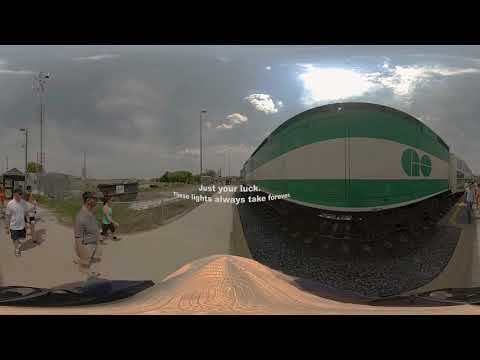Every three hours someone is hit by a train in the U.S. – mostly due to drivers going around gates or pedestrians using tracks as shortcuts. This #RailSafetyWeek, join us in taking the pledge to raise awareness for rail track safety.
— AAR (@AAR_FreightRail) September 18, 2022
From the Association of American Railroads: While the number of crossing collisions, deaths and injuries has dropped over the past five decades, it’s still a startling fact that about every three hours in the U.S., a person or vehicle is hit by a train.
There are countless reasons never to walk, run or play on rail tracks and rail property. Most people don’t know it can take more than a mile to stop a train — the equivalent of about 18 football fields. That makes it difficult, if not impossible, for a train to stop if someone is on the tracks. Trains are also deceptively quiet. Even when standing on a rail platform, it is unlikely a commuter will hear one approach, especially if wearing headphones. Pedestrians are not the only ones who need to be careful, drivers also need to play it safe behind the wheel at rail crossings. The force of a train hitting a car is equivalent to that of a car hitting a soda can.
Safety Tips
- Always Expect a Train: Freight trains don’t travel at fixed times, and schedules for passenger trains often change. Always expect a train at each highway-rail intersection at any time.
- All train tracks are private property: Never walk on tracks; it’s illegal to trespass and highly dangerous. Trains can’t stop quickly enough to avoid a collision. It takes the average freight train traveling at 55 mph more than a mile to stop.
- Think of a soda can: The average locomotive weighs about 400,000 pounds or 200 tons: it can weigh up to 6,000 tons. This makes the weight ratio of a car to a train proportional to that of a soda can to a car.
- Right of way: Trains have the right of way 100% of the time over emergency vehicles, cars, the police and pedestrians.
- A train can extend three feet or more beyond the steel rail: The safety zone for pedestrians is well beyond the three-foot mark. If there are rails on the railroad ties, always assume the track is in use, even if there are weeds or the track looks unused.
- Trains can move in either direction at any time: Sometimes, a train’s cars are pushed by locomotives instead of pulled, which is especially true in commuter and light rail passenger service.
- Trains are quieter than ever: Today’s modern, highly technological trains don’t produce that “clackety-clack” you see in old movies. Any approaching train is always closer and moving faster than you think.
- Obey the signs: Cross train tracks ONLY at designated pedestrian or roadway crossings, and obey all warning signs and signals posted there.
- Stay alert: Since trains are quiet and fast, you could easily miss an oncoming train if you have headphones on or you are distracted by your phone.

